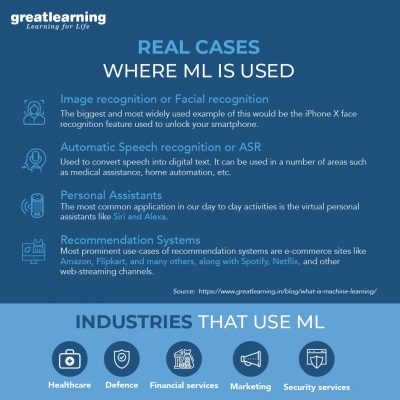
The cloud-computing industry has come a long since it became popular a decade ago. From being an IT enabling technology, to a ubiquitous computing platform, it is now going through a gradual shift towards becoming a bouquet of services built over an intelligent cloud. We all will agree to the fact that computer, storage, and networking continue to be the number one revenue source for cloud vendors but it is machine learning that is becoming the focal point of the contemporary cloud industry. In this article, we will look at five subclasses of the cloud that have changed rapidly with the advent of modern-day AI and ML technologies.
Machine learning or ML coupled with Artificial Intelligence or AI and Deep learning or DL has brought landslide changes in services offered by the traditional cloud.
The five areas that have seen maximal changes are the Internet of things or IoT, Cognitive computing or CC, Chatbots or Bots, Personal digital assistants or PDAs and Business Intelligence or BI.
The Internet of things or IoT is not a brand new technology. It existed for over two decades in different forms but it came to the forefront only after the advent of data-driven cloud platforms. ML helps in every aspect of an IoT pipeline right from capturing a massive amount of data from various sensors that are deployed to querying, processing and analyzing significant trends out of the captured data. Machine Learning adds a new intelligence layer over IoT. Industries are deploying IoT for Predictive maintenance where the platform will be able to detect faults or malfunctioning of devices much before they are noticed by users. It is possible by working multiple Machine Learning algorithms in tandem to generate the right model that is best aligned in understanding the pattern of datasets generated by devices. These models are designed to find beforehand whose anomalies that may eventually result in the breakdown of equipment or devices. Microsoft Azure IoT Suite and IBM Watson IoT are prominent examples in this use case of industrial IoT.
Cognitive Computing works with the sole mission to add sensory capabilities to applications. Cognitive means the knowledge of or knowing something. So Cognitive computing (or CC as it is fondly called) enables apps to see, listen, talk, and even make decisions. All these actions are possible by using underlying models for natural language processing, visual recognition, face detection, emotion detection, video analytics, and text to speech, speech to text, language translation, and sentiment analysis. Cognitive computing empowers developers with simple APIs for each subclass of problems. Applications use these services to deliver natural user experiences. It is machine learning that applies a variety of algorithms to provide these powerful cognitive capabilities. Though it looks deceptively simple, cloud providers have invested a massive amount of resources to deliver cognitive APIs to developers. All the main industry verticals, from insurance to BFSI, will start using Cognitive Computing platforms to provide a better experience to their customers. Amazon AI, IBM Watson, Google Cloud and Microsoft Cognitive APIs are all big players that are active in this domain and provide the best commercial offerings.
Chatbots or as they are fondly called Bots are now part of every service provider’s customer service pipeline. You should not be surprised to find a Chatbot as a prime customer contact point in many companies’ customer service offerings. Bots are superseding traditional apps by providing a conversational experience to consumers. With platforms like WeChat, WhatsApp, Facebook Messenger, and Slack gaining huge traction, the demand for embedding bots is increasing. AI ML developers can now train Bots based on past conversational patterns and let them auto-learn to drive meaningful discussions with consumers. A Chatbot identifies the emotions and context of a chat discussion and provides an accurate response. This direct staffing and monetary savings for companies enhance their operational efficiency. That’s why platforms like API.ai, IBM Watson Botkit and Microsoft Azure Bots as a Service are becoming popular names in the customer service domain and are slowly penetrating the CS pipeline of each organization.
Personal Digital Assistants or fondly called PDAs are very common with youngsters these days. Everyone loves to interact with Apple’s Siri or Amazon’s Alexa. As ML is becoming more and more advanced, it is turning voice-based personal assistants much more powerful than ever. All such digital assistants mine your past choices and usage trends to learn about them and they use this knowledge to help them in offering a customized experience. For example, given the time of day and your choice of songs heard over the last few days, they will be able to create a playlist that best suits your mood without your intervention. They will become smarter in the way you see the notifications and reminders. The APIs exposed by these assistants make any ML developer powerful enough to customize the experiences delivered to consumers as per their liking. Amazon Alexa, Apple Siri, Google Assistant, and Microsoft Cortana are examples of intelligent personal assistants powered by Machine Learning.
Check out some of the other use cases that ML has influenced

Business Intelligence or BI has found maximum traction in today’s businesses. Gone are the days of traditional data warehouses. With the advent of intelligent cloud, all such data warehouses are getting replaced by DW laced with Big Data and Apache Hadoop. Business leaders can get intelligent insights from existing data by incorporating Machine Learning into the enterprise data warehouses. This will empower them to forecast the trends much more accurately and quickly. Every domain including SCM, CRM, ERP, MRP, HR, Sales, and Finance will benefit from ML-driven insights. The top players that are forging connections between the traditional business intelligence platforms and the emerging ML-based tools are Amazon, Google, IBM, and Microsoft. It is easy to integrate Amazon Kinesis Analytics with Amazon ML or Azure Stream Analytics with Azure ML Web Services. All such tools are helping developers and architects to build next-generation business intelligence tools.
For businesses to grow without compromising on their quality and profitability, cutting edge technologies like Artificial intelligence and Machine learning must be widely implemented and adopted at all levels. AI/ML and the Cloud together can deliver greater efficiency, productivity, and digital security, both in terms of the information handled and the accuracy of the AI-structured processes and procedures.
Interesting Related Article: “What is the Cloud? What is cloud computing?“

